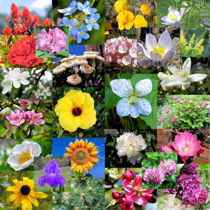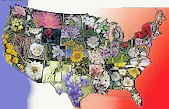Alabama Symbols
Alabama State Flower
Camellia

(Camellia japonica L.)
Adopted on August 26, 1959.
Specific Species in June, 1999.
A bill introduced in the 1927 legislature by Representative T. E. Martin, Montgomery County, making the goldenrod the state flower, became a law on September 6, 1927. The yellowhammer was adopted as Alabama's state bird on the same day.
The goldenrod was designated in 1927 as state flower was replaced by the camellia, Camellia japonica L., an exotic flower, possibly due to the erroneous idea that goldenrod pollen was annoying to those who are allergy-prone (actually, the goldenrod is falsely blamed for reactions caused by ragweed).
On August 26, 1959, the camellia became Alabama's new state flower. House Bill 24, approved August 26, 1959, amended Section 8, Title 55, of the Code of 1940, to read: "The camellia is hereby designated and named as the state flower of Alabama." (Acts 1959, No. 124.) No particular variety of camellia was designated.
Since Alabama's official colors are red and white, the red camellia is considered by some the official state flower. Camellias can also be white, pink, or a mixture. Alabama's state flower is the only symbol not native to Alabama. It's from Asia. Camellias are named for G. J. Kamel, a Jesuit priest who traveled in Asia in the seventeenth century. Camellia colors include white, pink, red, and mixtures. Some have suggested that red and red-and-white camellias represent the state, matching the red and white of the Alabama flag.
In June 1999, the Legislature designated that the camellia, Camellia japonica L., is the official state flower of Alabama.
Flower Chronology
- A bill introduced in the 1927 legislature by Representative T. E. Martin, Montgomery County, making the goldenrod the state flower, became a law on September 6, 1927.
- House Bill 24, approved August 26, 1959, amended Section 8, Title 55, of the Code of 1940, to read: "The camellia is hereby designated and named as the state flower of Alabama." (Acts 1927, No. 541.)
- In June 1999, the Legislature designated that the camellia, Camellia japonica L., is the official state flower of Alabama
Alabama State Flower: Camellia

The introduction of Camellia japonica L. in Italy is dated about 1760, but only during the 19th century this species became popular. Many Italian nurserymen started growing Camellias at that time and soon this business became of remarkable importance. In two areas, the Lucchesia (Tuscany) and the lake Maggiore zone, camellia production was famous, due to the local nurserymen, breeders, and collectors. In these areas camellias were grown in a great number of gardens and still today it is possible to find old specimens.
Camellias are evergreen shrubs, bloom in autumn and winter, and very popular because of their great beauty because of their flowers, form and also foliage. They grow in a habit form, have glossy leaves and exquisite form. Most Camellias at first were imported from Europe but now are grown in gardens from southeastern Virginia thru the Carolinas to Florida an along the Gulf Coast and even along the Pacific coast. They can also be grown in the house or outside.
They belong to the Tea family of plants. There are a number of varieties also and because of duplications in the plants there really isn't an actual count. The classifications are divided into three categories:
- Simple: All stamens central, single, with 5 to 7 petals, semi-double, with more than 7 petals.
- Double: All stamens converted to petaloids, imbricated, petals overlapped and Incomplete Imbricated, same as Imbricated but with a large unopened center. Also included are Tiered, petals arranged in tiers, and Irregular, petals in a compact mass without order.
- Incomplete Double: Petaloids mixed with stamens, Petaloids small, Petaloids large and Petaloids small and large, mixed.
Camellias like a cool winter season, but if you live in an area with high summer temperatures with lots of rainfall and winter with light frosts
you can grow Camellias. These plants do best when the thermometer doesn't go below l5 or 20 degrees.
Camellias need an acid soil with organic material and plant nutrients and the soil should be well drained and friable
The Code of Alabama
The law designating the camellia as the official Alabama state flower is found in Section 1-2-11 of the Code of Alabama, Title 1, Chapter 2, Section 1-2-11
TITLE 1.
Chapter 2. STATE SYMBOLS AND HONORS.
SECTION 1-2-11.
State flower; state wildflower.
(a) The camellia, Camellia japonica L., is hereby designated and named as the official state flower of Alabama.
(b) The oak-leaf hydrangea, Hydrangea quercifolia Bartr., is hereby designated and named as the official state wildflower of Alabama.
(c) Specimens of the state flower and the state wildflower shall be deposited in the Auburn University Herbarium.
(Acts 1927, No. 541, p. 627; Code 1940, T. 55, §8; Acts 1959, No. 124, p. 646; Act 99-313, ?1.)
Taxonomic Hierarchy: Camellia
Kingdom: Plantae - Plants
Subkingdom: Tracheobionta - Vascular plants
Superdivision: Spermatophyta - Seed plants
Division: Magnoliophyta - Flowering plants
Class: Magnoliopsida - Dicotyledons
Subclass: Dilleniidae
Order: Theales
Family: Theaceae - Tea family
Genus: Camellia L. - camellia
Species: Camellia japonica L. - camellia
State Floral Emblems








